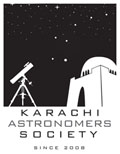Mud Volcano Star Party
Karachi Astronomy2021-01-15T05:20:57+00:00Our search for the perfect location around Karachi made us travel again; towards the west. New moon's phase coinciding with the weekend of 9th and 10th October 2010 was chosen for the event. We had learnt many lessons from our previous astro trips. But 'never a dull moment' did it to us. We started well but got late in making it to the proposed site. Hurried last minute search for the perfect observing site, resulted in deployment in the darkness. The first planned session which had involved observing and snapping the crescent Moon next to Venus slipped away from us. But [...]
